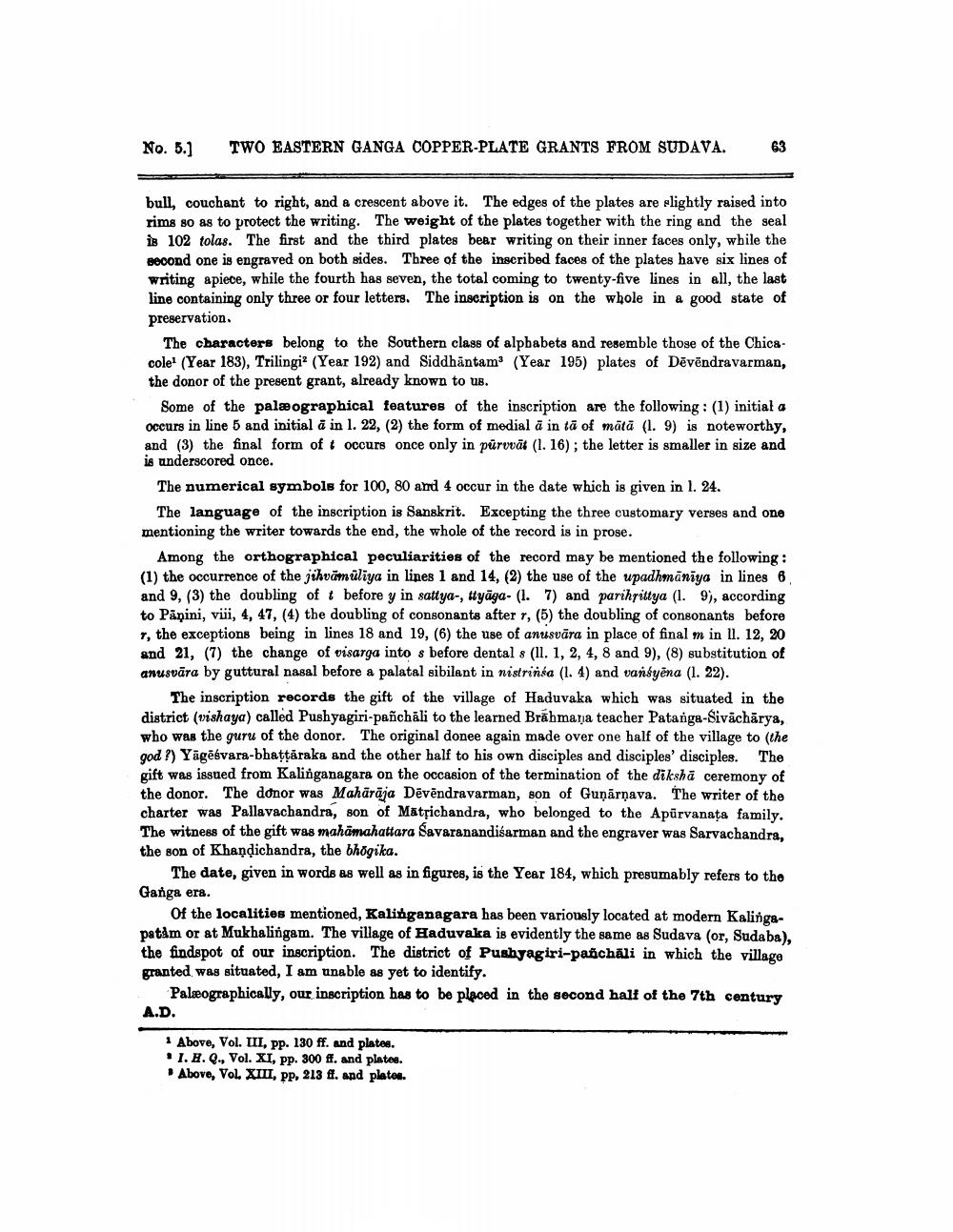________________
No. 5.)
TWO EASTERN GANGA COPPER-PLATE GRANTS FROM SUDAVA.
63
bull, couchant to right, and a crescent above it. The edges of the plates are slightly raised into rims so as to protect the writing. The weight of the plates together with the ring and the seal is 102 tolas. The first and the third plates bear writing on their inner faces only, while the second one is engraved on both sides. Three of the inscribed faces of the plates have six lines of writing apiece, while the fourth has seven, the total coming to twenty-five lines in all, the last line containing only three or four letters. The inscription is on the whole in a good state of preservation.
The characters belong to the Southern class of alphabets and resemble those of the Chicacole! (Year 183), Trilingi (Year 192) and Siddhāntam (Year 195) plates of Dēvēndravarman, the donor of the present grant, already known to us.
Some of the palæographical features of the inscription are the following: (1) initial a occurs in line 5 and initial à in l. 22, (2) the form of medial ä in tā of mätā (1. 9) is noteworthy, and (3) the final form of t occurs once only in püruvāt (1. 16); the letter is smaller in size and is anderscored once.
The numerical symbols for 100, 80 and 4 occur in the date which is given in l. 24.
The language of the inscription is Sanskrit. Excepting the three customary verses and one mentioning the writer towards the end, the whole of the record is in prose.
Among the orthographical peculiarities of the record may be mentioned the following: (1) the occurrence of the jihuümüliya in lines 1 and 14, (2) the use of the upadhmānīya in lines 6 and 9, (3) the doubling of before y in sattya-, ttyāga- (1.7) and parihrittya (1.9), according to Panini, viii, 4, 47, (4) the doubling of consonants after 1, (5) the doubling of consonants before 1, the exceptions being in lines 18 and 19, (6) the use of anusvāra in place of final m in ll. 12, 20 and 21, (7) the change of visarga into s before dental 8 (11. 1, 2, 4, 8 and 9), (8) substitution of anusvāra by guttural nasal before a palatal sibilant in nistrinka (1. 4) and vansyena (1. 22).
The inscription records the gift of the village of Haduvaka which was situated in the district (vishaya) called Pushyagiri-pañchāli to the learned Brāhmana teacher Patanga-Sivachārya, who was the guru of the donor. The original donee again made over one half of the village to the god ?) Yagēsvara-bhattāraka and the other half to his own disciples and disciples' disciples. The gift was issued from Kalinganagara on the occasion of the termination of the dikshā ceremony of the donor. The donor was Mahārāja Dēvēndravarman, son of Gunārņava. The writer of the charter was Pallavachandra, son of Mätsichandra, who belonged to the Apürvanața family. The witness of the gift was mahāmahattara Savaranandisarman and the engraver was Sarvachandra, the son of Khandichandra, the bhogika.
The date, given in words as well as in figures, is the Year 184, which presumably refers to the Ganga era.
Of the localities mentioned, Kalinganagara has been variously located at modern Kalingapatám or at Mukhalingam. The village of Haduvaka is evidently the same as Sudava (or, Sudaba), the findspot of our inscription. The district of Pushyagiri-pañchāli in which the village granted was situated, I am unable as yet to identify.
Palæographically, our inscription has to be placed in the second half of the 7th century
A.D.
1 Above, Vol. III, pp. 130 ff. and plates. .1.H. Q., Vol. XI, pp. 300 ff. and plates.
Above, Vol. XIII, PP, 213 ft. and plates.




